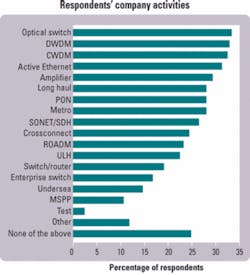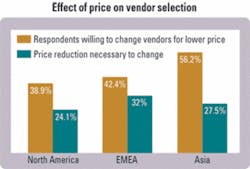Readers renew transceiver/transponder purchase discussions
When it comes to transceiver/transponder purchases, we know that in 2007, Lightwave readers viewed cost as only the third most influential factor in determining a supplier, that they were open to working with a start-up, and that most like to keep their options open as far as switching vendors. How do we know these things? We surveyed them, of course. Last year's survey results proved of such interest that we repeated the process in 2008. Once again, our readers weren't shy about telling us what is and isn't important when they're choosing a transceiver/transponder or a supplier.
As was the case in 2007, Lightwave conducted the reader survey this past February with the help of market and media research company iiON Corp. (formerly Advantage Business Research; www.iion.com). Our methodology was a bit different this year, in that we included not only Lightwave subscribers who had identified themselves as purchasers of transceivers and transponders when they subscribed to the magazine, but also their counterparts among subscribers to Lightwave Europe. The subsequent response base provided us with results that bore a margin of error no greater than ±6.4 percentage points at a confidence rate of 95%, iiON assured us.
Not surprisingly, the addition of our Lightwave Europe readers boosted the overall percentage of respondents from Europe, the Middle East, and Africa (EMEA) to a survey-leading 43.1%. North American readers made up 38.6% and Asian readers 13%; the remaining 5.3% came from other parts of the world. Nearly 44% of our respondents said they work at a company that designs and develops systems and subsystems, with another 28.5% employed with systems integrators, distributors, or consulting firms. An additional 12.6% work for a carrier or service provider, while 11.8% purchase transceivers/transponders within an end-user context. The wide variety of ways in which our respondents put these devices to use is illustrated in Fig. 1.
While the demographic profile of our respondents varied somewhat from last year, the factors transceiver/transponder buyers consider most important did not. We presented the respondents with a list of attributes and asked them to rate them on a scale of 1 to 10, with 1 being "Not at all important" and 10 being "Extremely important," in terms of their influence in the decision to purchase transceivers/transponders. The results mirrored last year's survey, with reliability ranked first (with a mean score of 8.80), performance second (a mean score of 8.62), and cost third (a mean score of 7.90). All three ratings were lower than last year's results, when the three factors earned scores of 8.99, 8.90, and 8.29, respectively. Customer service again came in fourth, with a mean score this year of 7.85 versus 8.19 in 2007, just ahead of the perceived stability of the production source at 7.82, down from 7.98 last year.
In fact, almost all of the attributes we asked our respondents to evaluate scored lower this year than last. Previous experience with the supplier was the only other attribute to score at least a 7.00, and then just barely; it rated a mean score of 7.08. Like last year, "previous experience" isn't the same as "current experience," since the fact that a particular vendor was also a current supplier rated only 6.12, behind such device-specific attributes as power consumption (6.90), availability of a second source (6.88), form factor (6.84), and tunability (6.65).
The survey therefore indicates that attributes of the device—reliability, performance, cost, etc.—tend to carry more weight than the characteristics of the potential supplier. The respondents underscored this fact when only 17% of them said that they either probably or definitely will not be likely to work with a start-up transceiver/transponder vendor. A larger percentage, 41.5%, said they either definitely would or probably would work with a start-up; an identical percentage was unsure. These figures indicated a greater willingness to work with emerging companies—that are likely to have a less established track record than many of their competitors—than last year's survey recorded.
Sales managers can breathe a bit easier—but only a bit—when it comes to keeping their customers, our survey revealed. A slightly larger percentage of respondents this year, 34.5%, said that they either probably or definitely will not switch suppliers during the life of a program. This compares to the 31.7% who made similar assurances last year. However, the number of clients who said they either probably or definitely will change suppliers remained the same, at 17.9%. And that leaves 47.6% on the fence—which means a total of 65.5% of current business may be in jeopardy.
What factors does the worried sales manager have to keep an eye on? The greatest number of survey respondents (65%) indicated that a shortfall in promised performance would lead them to switch suppliers. Failing on delivery promises was the second most likely catalyst for a supplier change; 56.9% cited this misstep. A redesign or update of the project would open the door for 52.4% of respondents. Our survey indicates that this factor has increased in significance; it was mentioned by only 38.6% of our respondents last year.
This last factor is the only one of the top three not within the incumbent supplier's control. However, there are plenty of reasons to fear the competition, even after the sale has been made; 48% of respondents said an offer of better performance would lead them to switch, with 41.5% saying a better price would be enough. Of this last group, a price change of just over 28% on average would do the trick. Perhaps surprisingly, North American respondents were least likely to switch based on price, but those who would had a lower cost savings threshold than their compatriots around the world (see Fig. 2).
So our survey reveals that, while individual percentages or scores may have changed a bit over the previous 12 months, the comparative importance of most of the factors we measured has not. However, the supplier landscape has change significantly since 2007—and, as we'll discuss next month in the second half of our survey report, our survey respondents have plenty to say about which companies they perceive as transceiver/transponder technology leaders.
Stephen Hardy is the editorial director and associate publisher of Lightwave.


